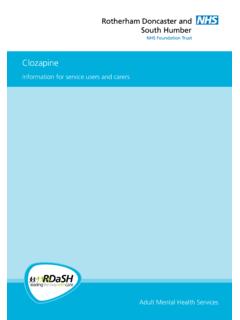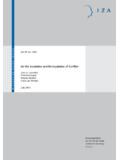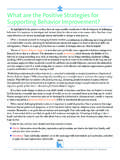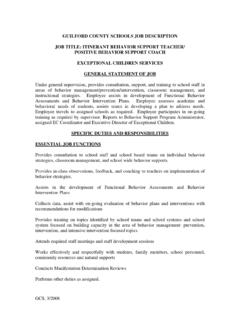Transcription of USE OF THE DE-ESCALATION ROOM - RDaSH NHS …
1 DOCUMENT CONTROL: Version: 1 Ratified by: Quality & Safety Sub-Committee Date ratified: 31 October 2016 Name of originator/author: Modern Matron AMH Doncaster Inpatients/ Coral Lodge Ward Manager Name of responsible committee/individual: Clinical Quality Group Date issued: 24 November 2016 Review date: October 2019 Target Audience All clinical staff and students USE OF THE DE-ESCALATION room Standard Operating Procedure Page 2 of 10 1. Aim The primary focus for managing patients who may present with disturbed or violent behaviour should be the provision of a positive and therapeutic culture; aimed at prevention, early recognition and DE-ESCALATION (Mental Health Act Code of Practice 2015 Chapter 26).
2 DE-ESCALATION is a secondary preventative strategy involving the gradual resolution of a potentially violent situation and the aim of this standard operating procedure is to ensure: The correct and appropriate use of the designated DE-ESCALATION room , by detailing the conditions and processes for its use. That there is a consistent approach to the use of the De- escalation room . Staff and patient safety by providing a framework for the correct use of the DE-ESCALATION room . This serves to emphasise and encourage the use of the DE-ESCALATION room as a less restrictive option in the management of disturbed / escalating behaviour. 2. Scope All clinical staff and students on placement.
3 3. Link to overarching policy and/or procedure The contents of this standard operating procedure are to be read in conjunction with the Trust Reducing Restrictive Interventions, Proactive Care policy. 4. Procedure DEFINITIONS DE-ESCALATION was defined by NICE guidance (NG10 2015) as a complex range of skills designed to abort the assault cycle during the escalation phase. The guidance also noted that a DE-ESCALATION room should be a low stimulus room , where a patient could go to calm down . DE-ESCALATION strategies promote relaxation, through the use of verbal and physical expressions of empathy and alliance (MHA Code of Practice 2015, p288) Supporting Information Adherence to this procedure is intended to ensure that the appropriate use of the DE-ESCALATION room will not inadvertently constitute a de facto seclusion.
4 Healthcare professionals must be aware that the following situations should be viewed as an incident of seclusion, unless the practice can be justified, even when the designated seclusion room has not been used: Placing a patient in a room with the door locked Page 3 of 10 Placing a patient in a room with the door held shut Placing a patient in a room in which his ability to leave is somehow restricted eg by suggesting that any attempt to leave the room will result in physical restraint or compulsory medication or other means. DIFFERENCE BETWEEN DE-ESCALATION AND SECLUSION TABLE 1 Differences Between the use of the de escalation room and Seclusion de escalation SECLUSION 1.
5 Always used with the patient s agreement (unless used to facilitate the safe disengagement of staff from Teamwork / RRI restraint). 1. Not negotiated with patient. Often implemented against the patient s will. 2. A therapeutic measure. Aims to reduce the patient s distress and propensity to harm self and/or others. 2. An Emergency Management Intervention Solely used to protect other people from physical aggression. 3. Patient can leave the DE-ESCALATION room , but may be encouraged by staff to stay. 3. Patient cannot leave the seclusion room , until staff assess that the risks have changed and the patient can be managed in a less restrictive manner. 4. The use of the DE-ESCALATION room is not time constrained and will take as long as needed.
6 4. Seclusion should be used as a last resort and for the shortest possible time. The decision to continue or cease attempts at DE-ESCALATION must be based on the clinical judgement of the nurse in charge of the incident. If there remains little perceivable prospect of continued DE-ESCALATION efforts being effective, then other alternatives as detailed in the patient s Behavioural Support Plan (BSP) should be considered; the use of prn(as required) medications, low level physical intervention. The patient will never be left alone in the DE-ESCALATION room unless previously agreed as part of their BSP. If appropriate, staff will remain within physical sight of the patient, and complete visual checks at regular agreed intervals.
7 NICE (2015) recommended that: All staff whose need is determined by risk assessment should receive on-going competency training to recognise anger, potential aggression, antecedents and risk factors of disturbed/violent behaviour and to monitor their own verbal and non-verbal behaviour. Training should include methods of anticipating, de-escalating or coping with disturbed/violent behaviour. Page 4 of 10 Rapid tranquillization, physical restraint and seclusion should only be considered once DE-ESCALATION and other strategies have failed to calm the patient (Mental Health Act 1983 Code of Practice ch. 26). The intervention selected must be a reasonable and proportionate response to the risk posed by the patient.
8 Verbal DE-ESCALATION should continue throughout the intervention, and negotiations with the patient to comply with requests to stop the behaviour should continue, where appropriate (Mental Health Act 1983 Code of Practice ch 26). DE-ESCALATION should not be seen solely as the placing of a patient in a room . Throughout any period of physical restraint staff should continue to employ DE-ESCALATION (Mental Health Act 1983 Code of Practice ch 26) DE-ESCALATION room Environment. Planned DE-ESCALATION should only take place in the designated room which is situated opposite the shared bathroom; it is situated away from the main ward area to provide a private low stimulus environment for the patient.
9 The DE-ESCALATION room contains specialist seating that enables staff to perform LLI DE-ESCALATION transfers (three seats wide and be sited against a wall). The door furniture (lock) enables the door to be locked from the outside when the room is not in use, but allows those inside the room to leave without a key. The room may contain additional equipment ( bean bag, games console, iPod) that will allow the patient to appropriately vent their feelings but access to and use of such equipment, will be strictly supervised by staff, and be identified as part of the patient s BSP. The DE-ESCALATION room will be checked in accordance with the weekly environmental Health & Safety checks, and any damage will be reported in a timely manner.
10 The nurse in charge will ensure that the DE-ESCALATION room is checked and fit for purpose before and after its use. Decision to use DE-ESCALATION . Planned DE-ESCALATION is agreed with the patient as part of their BSP. The nurse in charge is responsible for the decision to use the DE-ESCALATION room (in consultation with the clinical team) outside these parameters; patient risk assessment and BSP will be reviewed as part of this process. Page 5 of 10 DE-ESCALATION room and its staffing The escorting and support of the patient during a period of DE-ESCALATION will be determined by global risk assessment, including safe staffing levels. Consideration must be given to the Trust Policies regarding Supportive Observations, and Reducing Restrictive Interventions if the patient requires constant observation, or LLI during the DE-ESCALATION period.


![Depression Formulary Guidance [v2.1] - Welcome…](/cache/preview/e/4/c/e/4/7/b/1/thumb-e4ce47b1988d306ba6d4ee72b2c0f918.jpg)








